Neoacadian Poets in the Blue Ridge
Every spring my Earth Structure & Dynamics class visits the Appalachian Mountains on our weekend field trip. The goals of the trip are twofold: 1) practice doing structural geology in the field, and 2) decipher the geologic history of the Appalachians. It’s easy to achieve the first goal, as over the course of the weekend we use compasses to measure the orientation of geological structures, work out the sense-of-shear in fault rocks, and debate the nature of geologic contacts. The second goal is more difficult and less tangible. Rather than working out the geologic history of the Appalachians in the field, we commonly frame our observations and then build a narrative on that frame once we return to Williamsburg.
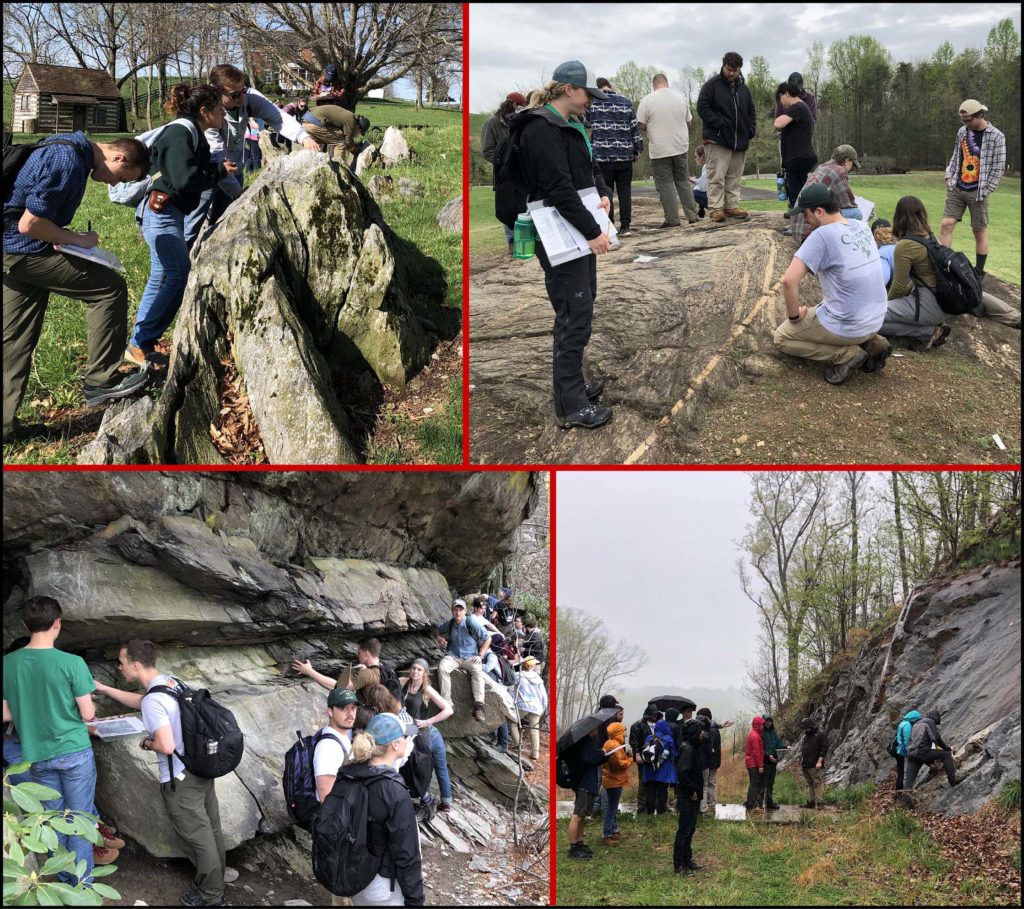
Images from the 2019 Earth Structure & Dynamics Appalachian field trip. Top Left: Examining an outcrop of Ordovician carbonate at McCormick’s Farm in the Shenandoah Valley. Top Right: Pondering folds in gneissic rocks at Hidden Rock Park in the Piedmont. Bottom Left: Geowallies tackling the big questions at White Rock Canyon in the Blue Ridge. Bottom Right: Working through the rain while examining Blue Ridge basement rocks at the Ragged Mountain Reservoir.
The internal structure of the Appalachians formed during a series of tectonic events in the Paleozoic era (540 to 250 million years ago). The traditional formation narrative for the Appalachians involves three separate orogenic (mountain building) events that occurred throughout the Paleozoic. Generations of geology students have been forced to memorize the ‘Holy Trinity’ of eastern North American orogenies – the Taconic (Taconian), Acadian, and Alleghanian orogenies. On exams, students dutifully parrot back these memorized orogenic events without much understanding of what actually transpired and how geologists know of these events.
Orogenies, like geologic time periods, rock units, and structures are typically named for particular locations. For instance, the Catoctin Formation is named for exposures on Catoctin Mountain, Maryland, while the Brevard fault zone is named for the town of Brevard, North Carolina, and the Devonian Period takes its names from Devon, England where rocks of this age are common. The intention is to ascribe a specific type location as a reference locale for future study. Thus, geographic place names are co-opted by geologists, and employed to describe particular geological features or events that occurred in the distant past.
Other academic disciplines also ‘borrow’ terminology1, but this is a curious geological practice, nonetheless. Here’s a conversation between two geologists in the field –
Geologist 1- “Look at that drab outcrop of metagraywacke exposed in the creek, definitely Lynchburg with a Taconic foliation.”
Geologist 2-“Slow down, champ! Anybody can see that’s Bassett, also we’re so far east of the Brevard surely that’s an Alleghanian fabric.”
Lynchburg and Bassett are communities in southern Virginia, but in this context, the geologists are referring to the Lynchburg Group and Bassett Formation – geologic units. The Brevard is a fault zone, and Taconic and Alleghanian are orogenic events, but in this context, are being used as time terms. Sounds like crazy talk.
___________________________________________________________
The Taconian orogeny takes its name from the Taconic Mountains of western Massachusetts and eastern New York. The Acadian orogeny is named for Acadia, an expansive region from Canadian Maritime provinces to Down East, Maine that was settled by French colonists in the 17th and 18th centuries. The Alleghanian orogeny is named for the mountains that stretch from West Virginia northward across Pennsylvania. Timewise, the Taconian occurred during the late Ordovician and into the Silurian (470 – 445 Ma), the Acadian during the Devonian (410 –360 Ma), and the Alleghanian from the Pennsylvanian to the Permian (310 – 260 Ma). The duration of these events is a bit fuzzy, and orogenies tend to be time transgressive along the length of the Appalachians.
In the modern world, mountains are currently being formed in the Himalayas, the Andes, and the Zagros – regions experiencing active deformation (as illustrated by frequent earthquakes) and uplift. But how are episodes of mountain building from the geologic past recognized?
Ancient orogenic events are identified based on three primary sets of observations:
- Suites of plutonic or volcanic rocks that form at a particular time; these arc-related igneous rocks form when tectonic plates collide.
- Deformed and metamorphosed rocks of a particular age. During plate collision, earth materials become fodder for the tectonic cannon and, in the process, enjoy deformation and metamorphism.
- A clastic wedge of sedimentary rocks forms by erosion of the growing mountain range. As uplift occurs and topography is generated, sediment is shed from the highlands into adjacent basins. This sedimentary evidence may accumulate hundreds of kilometers from the mountainous terrain.
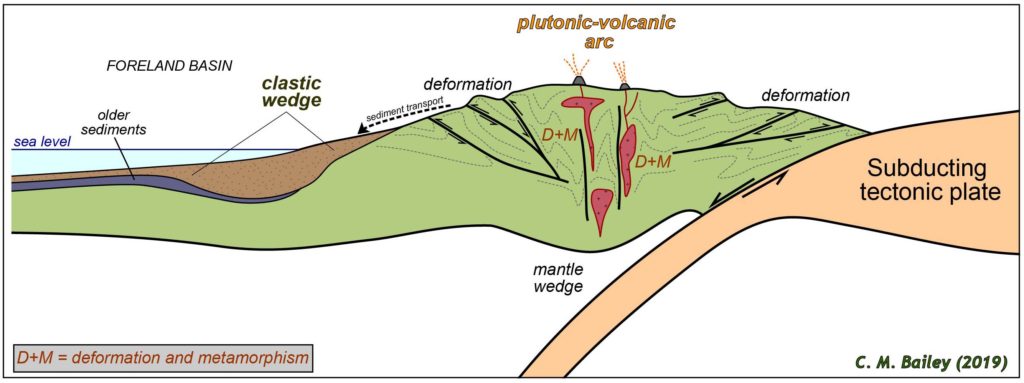
Simplified two-dimensional model illustrating components of an orogenic event: plutonic-volcanic arc, zone of deformation and metamorphism, and the clastic wedge in the foreland.
On our recent field trip, we spent time traversing the Blue Ridge Mountains in central Virginia. Although the Blue Ridge highlands formed in the more recent geological past, the rocks that crop out in these mountains are old and distinguished.
At White Rock Canyon, we examined Early Cambrian sandstones and foliated siltstones. At the Greenstone Overlook, we noted that the columnar joints in the Ediacaran Catoctin Formation were ‘squished’, while at Rockfish Gap these same Catoctin greenstones were strongly foliated with meta-sandstone boudins. At the Ragged Mountain Reservoir, we observed mylonitic shear zones cutting across the Precambrian basement rocks.
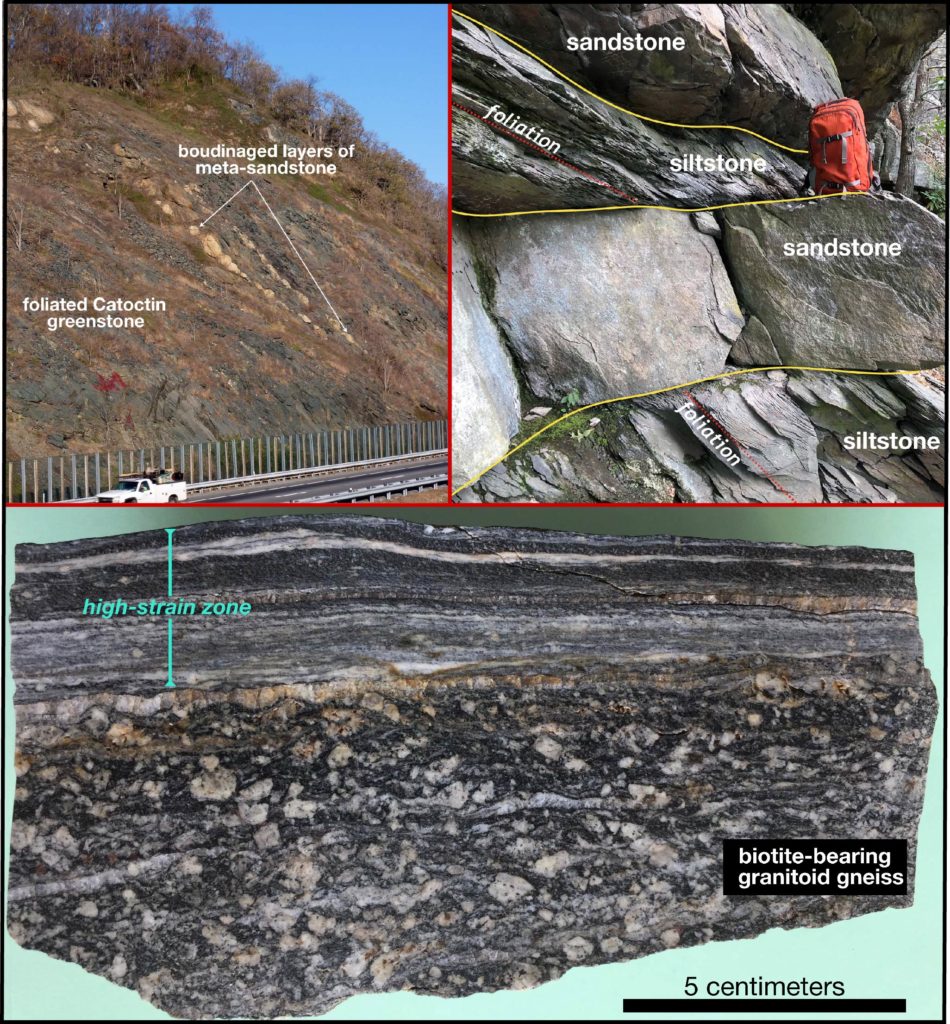
Montage of deformation features in the Blue Ridge, from the mega-scale to nearly micro-scale. Top Left: foliated greenstone and boudinaged layers of meta-sandstone exposed in the roadcut above Interstate 64 at Rockfish Gap, Virginia. Top Right: Interlayered sandstone and foliated siltstone at White Rock Canyon. Orange pack is ~40 cm tall. Bottom: Centimeter-scale high-strain zone cutting Mesoproterozoic biotite-bearing granitoid gneiss from the exposure at the Ragged Mountain Reservoir.
When did all this deformation occur in the Blue Ridge?
For decades, geologists have argued about when deformation occurred in the Blue Ridge. In 1993, I published on Blue Ridge shear zones, and made a case that ductile deformation in Blue Ridge rocks likely occurred during the Taconian orogeny. Yet, my study was a structural and kinematic endeavor, not a geochronological study.
In this century, working with the U.S. Geological Survey, we (primarily my research students Katie Wooten ’05 and Chelsea Jenkins ’11 – they did the difficult work) collaborated on a geochronology campaign across the Blue Ridge to determine when the rocks in the region were folded, faulted, and metamorphosed. Ultimately, we obtained more than 60 40Ar/39Ar age spectra from a suite of K-bearing minerals in numerous geologic units. Muscovite is a minor, but common enough, mineral in these deformed and metamorphosed Blue Ridge rocks, and its closure temperature is ideal for dating deformation and low grade metamorphism.
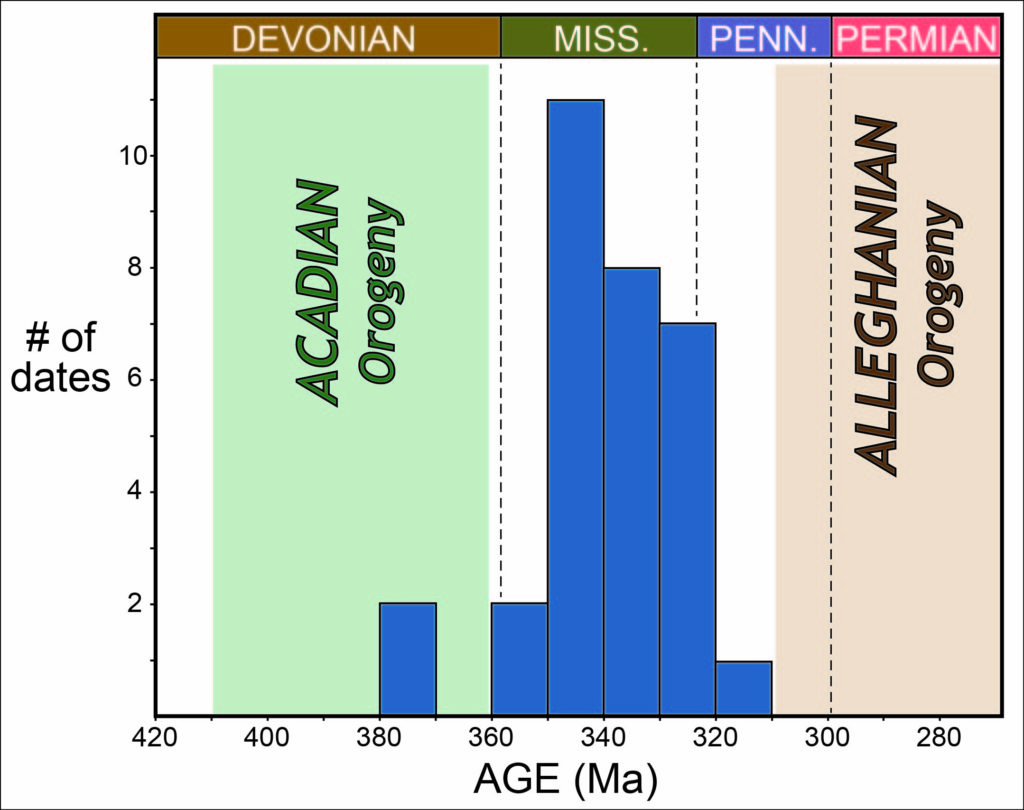
Histogram illustrating the number of 40Ar/39Ar muscovite/sericite ages (in 10 Ma bins, n = 31) from the Blue Ridge province in central and northern Virginia. Most ages are Mississippian (Miss.) between the classic Acadian and Alleghanian orogenies. Data from Kunk and Burton (1999), Wooten (2005), and Jenkins et al., (2012).
40Ar/39Ar muscovite ages across the Blue Ridge range from 378 to 312 Ma. There is a broad spread in the ages, but these data indicate that ductile deformation and metamorphism occurred primarily in the Mississippian – squarely between the classic Acadian and Alleghanian orogenies. What’s up with that?
In the last decade, similar geochronological results were obtained across the central and southern Appalachians, and a new (?) orogeny has come to be – the Neoacadian orogeny. Not all researchers embrace this terminology or the addition of another orogeny to the parade of Paleozoic orogenies. But with new data, new ideas and models must emerge.
Upon our return from the Blue Ridge, the 2019 Earth Structure & Dynamics class embraced the Neoacadian orogeny to such a degree that I’ve taken to calling them the Neoacadians2. They’ve got a 21st century take on the Acadian flag (with a structural flair, of course). Rumor has it that a Neoacadian anthem is under commission.
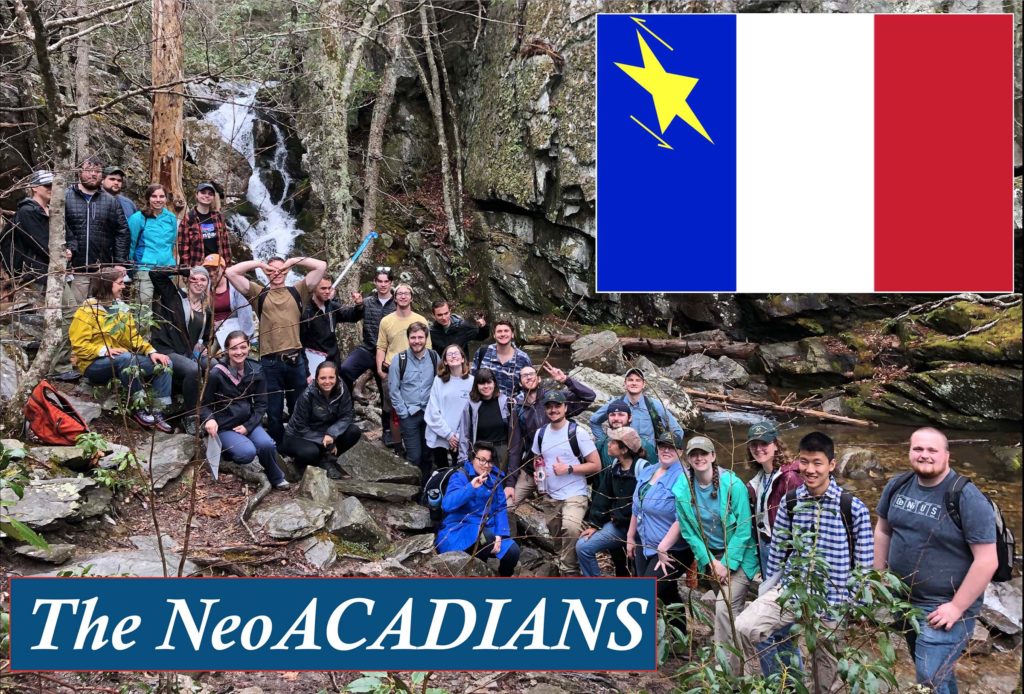
The 2019 William & Mary Earth Structure & Dynamics class (a.k.a. the NeoAcadians) at White Rock Falls in the Blue Ridge.
The Neoacadians are not only geology scholars, but some are poets. In the days since the field trip, their deep and prolonged reflections about the trip generated a few poems about our Blue Ridge adventures. Once again the geologists are bold enough to reach across the liberal arts.
The 2019 Earth Structure & Dynamics class made it a fun and engaging semester. No doubt, they’ll carry on with their special brand of Neoacadian élan in their future academic endeavors.
Footnotes:
1– Sociologists are notorious for ‘borrowing’ terms from other academic disciplines, for instance they’ve scammed climate, landscape, longitude, seismic shift, and terrain from just the earth sciences!
2– The Acadians were forcibly removed from Acadia by the British during and after the French & Indian War (1755-1764). Many of those Acadians settled in Louisiana, and we should thank them for both Cajun cuisine and music.
Comments are currently closed. Comments are closed on all posts older than one year, and for those in our archive.

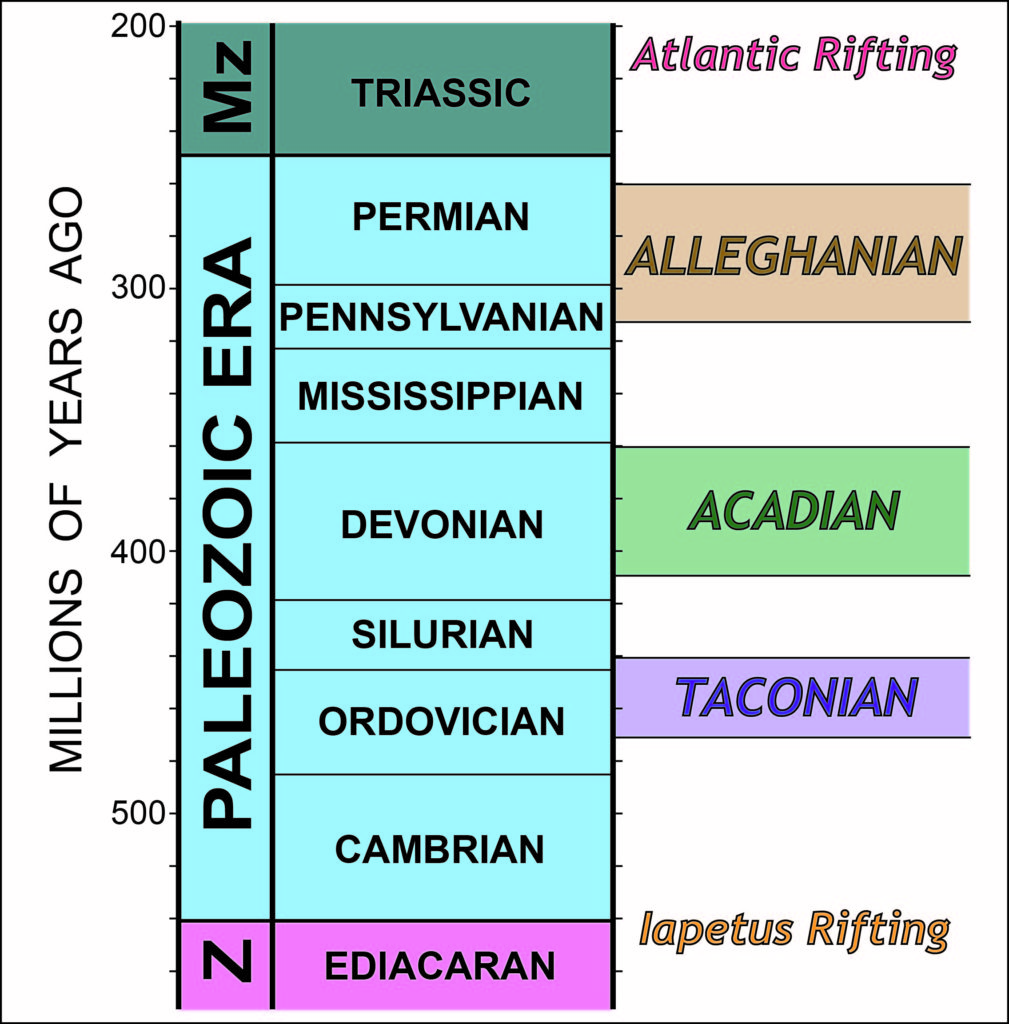
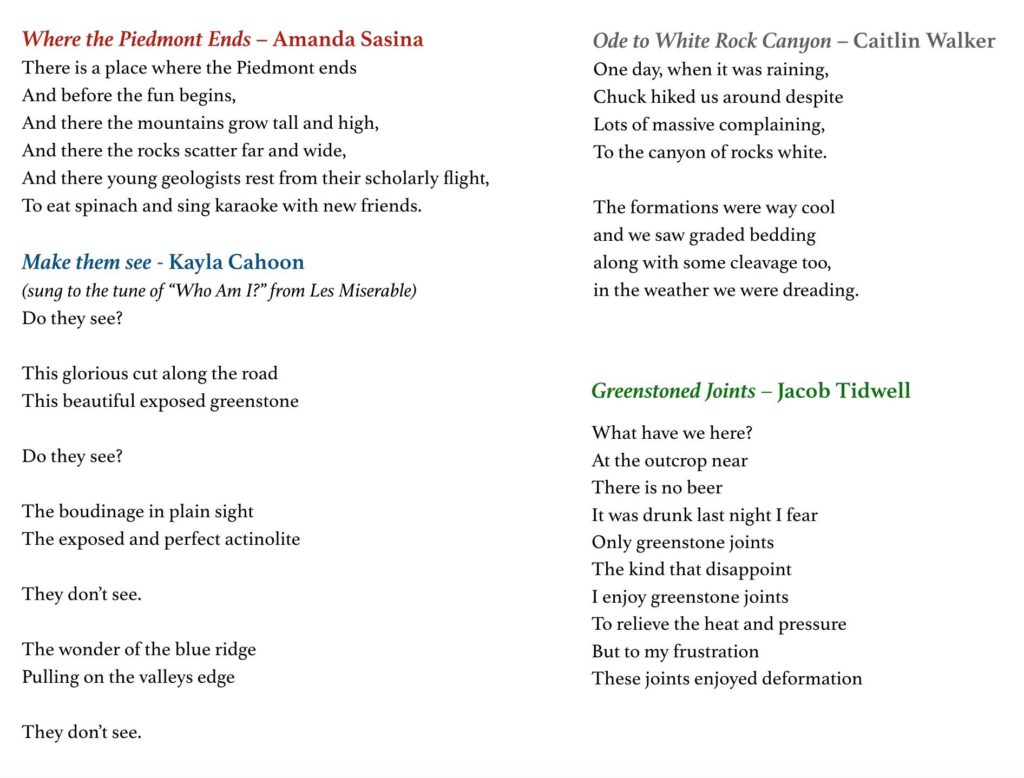
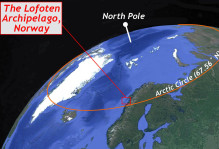


Superb article. I have some lingering questions after this intellectual journey. If horizontal compressional stress was applied to the hay-wagon would it buckle or fold? Are there non-tectonic events that can create fractures? For example, if a wizard launched the throne room into the White Rock Canyon outcrop at ~10,000mph, would that create enough stress to fracture the interbedded sedimentary rocks? Do you think you could persuade (or bribe) the wizard to spare the throne room? Thanks.
What an informative piece, but I wish it mentioned the SRA!
Agreed. Excellent read – a real page turner! My two cents on the matter is that, with enough compressional stress, the hay-wagon would actually fracture and be left Chuck-full of brittle deformations. However, if the horizontal stress were imbalanced (i.e. more of a lateral shear force than a compressional force), I might predict that the wagon would be “rolling deep”, offering fresh insight into an oft-pondered query. I personally was wondering about the correlation between fauna and lithology. For example, was sheep presence strongly tied to Ordovician carbonate? More broadly, why were some animal teams fortunate enough to see their animals in the field, while others were not? And finally, what is a trash panda anyways? Truly stimulating stuff.
Goodbye Gondwana,
Farewell Iapetus,
Go create Pangaea
And leave us the impetus
To pull flat the Blue Ridge
And raise the valleys.
We’ll quantify deformation
And right the tallies:
Was it Alleghanian?
Or perhaps Taconic?
Wait when even were they???
Thank you https://www.youtube.com/watch?v=dOOWhfdYU_4 for the brilliant mnemonic.
T’was NeoAcadian,
or so we are told.
Thanks to 40Ar/39Ar geochron,
And our unfolding some folds.
I’ve yet to be confident
In my parroting skills
But I am quite certain
I am a better geologist than poet.
This Neoacadian stuff is all fine and grand…but it now opens a whole new set of questions about the tectonics of the time period. If this is a newly discovered orogeny, then what landform crashed into ancient North America to create the deformations seen in the rocks of the Blue Ridge Mountains? Some more research would definitely have to be undertaken @risingjuniorgeomajors. Perhaps some more geochronoloy to better nail down those dates of deformation… and also some zircon dating that might give insight to the age of the parent material. Can we match up this parent material with other rock bodies found in this or other continents? What knowledge can be gleaned from the geologic structures found in exposed outcrops? This information may better paint the geologic picture of the ~Neoacadian orogeny~
Chuck, the entire class hopes you will continue on with your élan of wearing bright, unusually colored bicycling shirts. In honor of the field trip, may I suggest, on behalf of the ES&D class of 2019 that you purchase a new shirt with a design that resembles the folding of the 3 (now 4! – maybe) Paleozoic orogenies that Virginia suffered through to make this experience possible. These rocks, as they experienced all the deformation, were thinking about how great it will be in 340 Ma to provide Dr. Chuck Bailey with a career as a geologist so he can bring 100s of enthused undergraduate college students to look at rocks and entertain the locals. I hear they consider the Structure field trip to be a holiday in Crozet.
Also, consider how many colors this new shirt could have. It would be wild. Your wife will love this one. You can say your students bought it for you, although we probably won’t.
Thank you for the great blog posts, Chuck! I’ll be sure to keep reading them for future geologic insights. This post made me particularly emotional, making me remember all the fun times in this class. So emotional, in fact, that I wrote a haiku.
Neoacadians: A haiku
Forever, I know
I will always remember
This trip to Blue Ridge
It’s not as inspiring as this blog post, but I think it’s close.
Now that the Final is over, I decided to express my feelings on our field trip through the only way I know how, song parody.
The Gifts
Sung to the tune of “The Weight” by The Band
Pulled up to McCormick, keen to find some carbonite seds
Chuckie said, “Hey friends, now orient these beds!”
“Facing indicators are where?” I said as I scratched my head
Chuckie said, “This is covered, in the chapters that you read”
Give me a hint now Chuckie, Give me a hint pretty please
Give me a hint now Chuckie,
And… go easy on us Geowallies
Piled into the vans, headed for Table Rock
Shaking in anticipation, to see some upthrown blocks
“Chuckie this trail is long, why we here, please tell me why”
He smiled and pointed to at Grenville Granite a mile high
Give me a hint now Chuckie, Give me a hint pretty please
Give me a hint now Chuckie,
And… go easy on us Geowallies
Went down the road to look at the breccia’s fault
Chuckie said “time to see if you all are worth your salt”
I said, “Hey Chuckie, I don’t know if I’m wrong or right”
He smiled and said, “It’s meta sandstone, not quartzite”
Give me a hint now Chuckie, Give me a hint pretty please
Give me a hint now Chuckie,
And… go easy on us Geowallies
It rained the next morning and soaked us to the bone
But we had more outcrops to see on our long drive home
Last stop was Hidden Rock, Chuckie got a round of applause
There at our feet was a beautiful boudinage
Give me a hint now Chuckie, Give me a hint pretty please
Give me a hint now Chuckie,
And… go easy on us Geowallies
So proud to be a part of the Neoacadian Kingdom. It turns out radiometric dating is still the supreme method to determine the chronology of geologic events. Relative relationships like cross-cutting relations and regional geological relations are crucial pieces of evidence, but they are not nearly as accurate as state-of-the-art dating methods. Unfortunately, the king of the Neoacadian Kingdom overlooked this reality 26 years ago, leading up to a few loss in battles against the Royal British Army. He was eventually captured by the British troop and sent to Willamsburg, where he was forced to teach structural geology to some royal subjects. This is the end of the story.